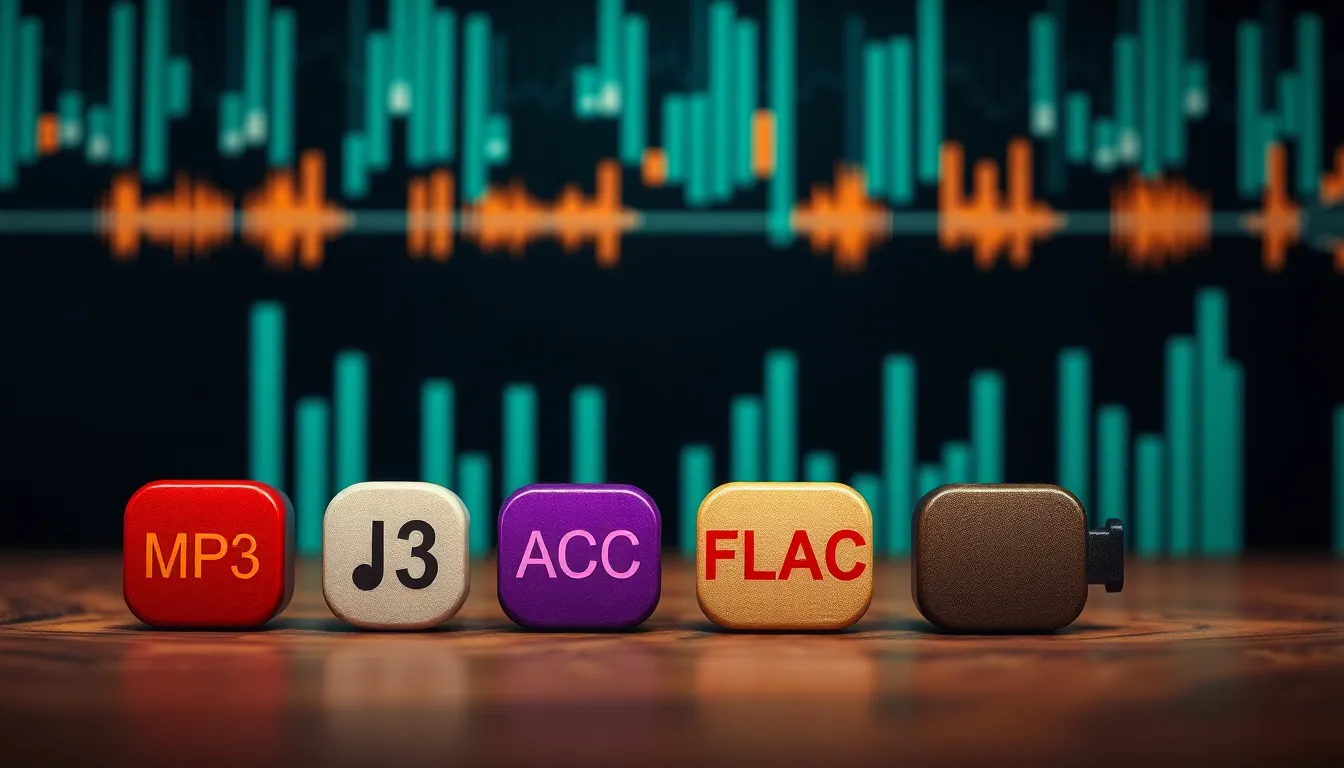Table of Contents
ToggleIn a world where sound can make or break an experience, audio codecs are the unsung heroes of the digital age. They compress and decompress audio files, ensuring that your favorite tunes don’t just sound good—they sound great. Imagine listening to your favorite podcast, only to be interrupted by garbled audio reminiscent of a 90s dial-up connection. Not ideal, right?
Overview of Audio Codecs
Audio codecs play a crucial role in sound quality and file size management. They compress and decompress audio files, enhancing the overall listening experience.
What Are Audio Codecs?
Audio codecs encode and decode digital audio data. Common examples include MP3, AAC, and OGG. Each codec serves a different purpose based on desired quality and file size. Specifications vary, with some prioritizing high fidelity while others focus on efficient compression. The choice of codec impacts playback on various devices, ensuring compatibility and sound performance.
Importance of Audio Codecs in Digital Media
Audio codecs significantly affect media consumption. High-quality codecs enhance clarity and richness in sound, creating a better experience for listeners. They enable seamless streaming by balancing audio quality with file size, crucial for fast internet connections. Various codecs meet different needs, from music streaming to podcast production. Selecting the right codec can improve audio performance on platforms like Spotify or Apple Music.
Types of Audio Codecs

Different types of audio codecs cater to specific audio quality needs and file size requirements. Understanding these categories helps in making informed decisions for optimal audio performance.
Lossy Audio Codecs
Lossy audio codecs reduce file sizes by permanently discarding some audio data. These codecs, such as MP3 and AAC, prioritize smaller file sizes over retaining every detail of the original sound. Most consumers prefer them for casual listening, as they balance quality and space efficiency. Common applications include streaming services like Spotify and apps like Apple Music. High levels of compression often lead to a noticeable decline in sound quality, especially at lower bit rates. For everyday use, these codecs are usually sufficient, though audiophiles may seek better alternatives.
Lossless Audio Codecs
Lossless audio codecs preserve all original audio data, ensuring no loss in quality during compression. Examples include FLAC and ALAC, appealing to audiophiles who demand pristine sound. These codecs maintain full fidelity, enabling high-resolution playback on compatible devices. They compress files without any data loss, allowing for high-quality streaming and storage. Users enjoy the crispness and clarity of lossless audio during playback. Though file sizes can be larger than lossy alternatives, the trade-off is often worth it for serious music listeners.
Popular Audio Codecs
Audio codecs play a vital role in audio quality and file management. Several codecs dominate the landscape, each tailored for different use cases and preferences.
MP3 Codec
MP3 codec stands as one of the most popular audio formats globally. Its widespread adoption stems from efficient compression that reduces file sizes significantly, making it easy to store and transfer music. While the codec’s lossy nature compromises some audio quality, the difference is often negligible for casual listeners. Bit rates ranging from 128 kbps to 320 kbps allow users to select quality levels based on needs. This versatility and compatibility with nearly all devices solidify its status in the digital audio world.
AAC Codec
AAC codec improves upon MP3 by delivering higher quality audio at similar bit rates. It achieves better sound reproduction due to advanced compression techniques. As a lossy format, AAC maintains musical details critical for genres like pop and rock. Devices such as Apple products commonly support this codec, enhancing the streaming experience on platforms like Apple Music. Bit rates of 64 kbps to 256 kbps make AAC suitable for both casual listening and mobile use, appealing to users who prioritize quality without excessive file sizes.
FLAC Codec
FLAC codec represents a go-to choice for audiophiles seeking pristine sound quality. Unlike lossy codecs, FLAC is lossless, preserving original audio data during compression. It allows users to experience music as intended by the artists, capturing every nuance. Most FLAC files range from 600 kbps to over 1,500 kbps, implying larger file sizes but offering unmatched fidelity. Many high-resolution audio systems and streaming services support FLAC, making it essential for those who appreciate detailed soundscapes.
Audio Codec Applications
Audio codecs play a vital role across various sectors, enhancing sound quality and user experience. Their applications range from streaming services to audio production.
Streaming Services
Streaming services heavily rely on audio codecs to deliver high-quality sound. Popular platforms like Spotify and Apple Music utilize codecs to balance file size and audio fidelity. The AAC codec shines in this area for its efficiency, providing superior sound at lower bit rates. Users enjoy seamless playback without sacrificing quality. Additionally, these codecs facilitate adaptive streaming, adjusting audio quality according to internet speed. This ensures that listeners receive the best experience regardless of their connection.
Audio Production
In audio production, codecs are essential for maintaining sound integrity during recording and editing. Lossless codecs like FLAC and ALAC are favored among producers for their ability to retain original audio data. The clarity and detail in sound make a significant difference in professional music and film projects. Comparatively, lossy codecs such as MP3 find their utility in preliminary drafts and quick reviews, where file size becomes a priority. Producers choose the right codec based on the project requirements, ensuring optimal sound quality throughout the production process.
Audio codecs play a vital role in shaping the listening experience across various platforms. By understanding the differences between lossy and lossless codecs, users can choose the right format that aligns with their audio preferences and needs. Whether it’s the convenience of MP3 for casual listening or the pristine quality of FLAC for audiophiles, the right codec can significantly enhance sound clarity and richness.
As streaming services continue to evolve, the importance of selecting efficient codecs becomes even more apparent. By making informed choices, listeners can enjoy high-quality audio that meets their expectations, ensuring every note is heard as intended.

